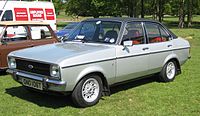Ford Escort (Europe)
![]()
The title of this article is ambiguous. Further meanings are listed under Ford Escort (disambiguation).
![]()
This article or section needs revision. More details should be given on the Discussion page, under "Outline, Contradictions". Please help improve it, and then remove this marker.
Ford Escort is the name of several compact or lower-medium passenger car models produced in Europe from the fall of 1967 to the summer of 2000 by automaker Ford.
After the Transit, the Escort was the second joint project of the German and British Ford branches.
On the platform of the third generation of the Escort, the independent notchback model Ford Orion was produced from summer 1983 until the end of 1993. In terms of registration figures, the Escort was one of the best-selling cars in Europe.
From spring 1981 to early 2003, there was also an American Escort, initially related to the European model, but later based on the Mazda 323 platform.
The successor in Europe was the Ford Focus in autumn 1998.
In summer 2014, the model name "Escort" was revived for the Chinese market for a new model generation. It is the first Ford brand vehicle developed exclusively for China.
The Escort model designation was used as early as the 1950s for a simply equipped version of the Ford Squire.
Escort '68 (1967-1974)
| 1st generation | |
|
Ford Escort (1967-1974) | |
| Production Period: | 11/1967–10/1974 |
| Body versions: | Sedan, station wagon |
| Engines: | Petrol engines: |
| Length: | 3978-4070 mm |
| Width: | 1565-1572 mm |
| Height: | 1391-1425 mm |
| Wheelbase: | 2400 mm |
| Tare weight: | 825-900 kg |
Model history
The first independent model developed by the British Ford plants with the name Escort was produced in Halewood, UK, from 17 November 1967. On the British market it replaced the technically similar Ford Anglia, in Germany it rounded off the range.
At the beginning of January 1968, the Escort with its characteristic radiator grille (also called "dog bone") was presented to the press in Morocco. A few days later, the official presentation took place on the occasion of the Brussels Motor Show. Sales figures exceeded the manufacturer's optimistic expectations by 30% after just two months. Less than five months after the presentation, the 100,000th Escort rolled off the production line in Halewood on 4 June 1968. In Germany, the first car left the factory in Saarlouis on 16 January 1970. The cars sold in Germany in 1968 and 1969 were produced at the British plant.
Ford took over the technology in essential parts from the predecessor model Anglia. The Escort was very popular, especially in Great Britain, but fell short of the expected unit sales in Germany. The Beetle from market leader Volkswagen was technically outdated but better made, and in addition there were established and in some areas superior alternatives in the form of the Opel Kadett B and French and Italian imported cars.
In mid-1973, the RS2000 was added as the top model in West Germany. It was recognizable by the striking two-tone paint and the widened wheel arches at the front. With 74 kW (100 hp) the light Escort achieved many successes in motor sports. Far more successful in international motor sport, however, were the British Escort TwinCam and its successor, the RS1600 with Cosworth BDA-16V engine. With this engine, the RS1600 won the 1973 European Rallycross Championship, the Finland round of the World Rally Championship and several rounds of the German Racing Championship.
Motorsport
The Escort was originally designed with no regard for motorsport requirements. However, Ford Motorsport organised an early example and carried out fit tests of the Lotus Cortina's mechanics over a weekend. The front axle of this competition car fitted without any problems, and the rear axle did likewise with only minimal modifications. However, due to its protruding cylinder head with cast-on intake ducts and the voluminous carburettor and air filter system, the Lotus engine did not fit under the bonnet until the front end of the engine was moved a few centimetres to the (in the direction of travel) left-hand side. So the engine didn't sit neatly straight in the engine bay, but twisted a bit to the left. The battery had to be moved into the boot to make room for the exhaust.
To accommodate the Cortina's significantly larger transmission, the bulkhead and transmission tunnel were modified accordingly with a two-pound hammer.
The changes to the body were limited to slightly wider rear fenders to cover the wide rear axle, flared front wheel arches, reinforcing plates on the strut mounts and the modified transmission tunnel. Such bodies ran in production as "Type 49" and had chassis numbers beginning with "49".
The resulting model was produced as the Escort Twin Cam initially in regular production at Halewood and completed in a remote corner of the factory. About 1,100 vehicles were produced there. However, when management realized that there was a shortfall of one and a half regular Escorts for every 49er body, production at Halewood was terminated. Further examples were built at Ford Motorsport in Boreham.
The Lotus engine gradually proved to be insufficiently powerful and also not particularly reliable in sporting use, in addition to being complex and expensive to maintain. Cosworth was therefore commissioned to design a new four-valve cylinder head for the existing block. The resulting BDA engine replaced the Lotus four-cylinder in the otherwise unchanged car, which was then marketed as the Escort RS 1600. The BDA engine was also installed at an angle in the engine bay, although this would no longer have been necessary due to its considerably slimmer dimensions. The BDA had 1601 cc, taking advantage of all manufacturing and repair tolerances, and was therefore allowed to be increased in sport to two litres capacity. Several hundred examples of the RS1600 were built in Boreham. With the available grey cast iron block however not more than 1835 cm³ were realizable. The external tuner Brian Hart had constructed without knowledge of Ford on own initiative an aluminium engine block which could replace the grey cast iron block and offered the possibility to realize two litres of displacement.
The sports models had a capacity of two litres and rear axles with four trailing arms (the two upper ones pointing backwards), a Panhard rod and coil springs. With such vehicles, the Ford team with drivers such as Roger Clark, Timo Mäkinen and Hannu Mikkola achieved numerous successes in rallying.
Ford made all developments of the factory team generally available via its well-developed RS dealer network, especially in Great Britain, as soon as they had proven to be useful and stable. In this way, every team was able to prepare vehicles to factory standard, provided it had the necessary financial strength. As a result, Ford often lost out to private teams in competitions, but this was not disliked for marketing reasons. Thus Escort RS became very popular competition cars in Great Britain. There was the phrase that every weekend somewhere in the UK there is some event that is won with an Escort.
· 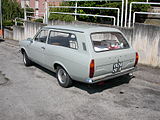
Ford Escort Tournament (1969-1974)
· .jpg)
Ford Escort four-door (1969-1974)
· 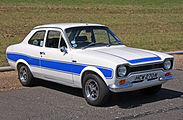
Ford Escort RS2000 (1973)
· 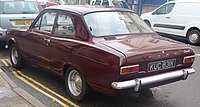
Rear view (1969-1974)
· .jpg)
Dashboard (1969-1974)
Body
The Escort was designed by its developers as a notchback saloon with a self-supporting all-steel body. The two-door sedan appeared first, followed by a three-door station wagon (called "Turnier" at Ford) from April 1969. From September 1969 Ford also offered a four-door saloon and a panel van.
The boot of the saloon had a capacity of 270 litres, the estate had a load volume of 1.53 m³.
The cars basically had round main headlights, only the upscale "Super" trim was delivered with rectangular headlights.
Landing gear
The chassis of the Escort is kept simple. The front wheels are suspended on MacPherson struts and wishbones - longitudinally the front wheels were guided by push rods in the first English Escort series. On cars of German production a transverse stabilizer was used for this purpose. This wheel guidance was later adopted for the English models as well. The steering was new, with pinion and rack.
The rigid rear axle was initially guided exclusively on semi-elliptic leaf springs and fitted with sloping shock absorbers. In the course of the model update, the rear axle later received additional trailing arms.
Brakes
At model introduction, the 1100 models were equipped with drum brakes on all four wheels. The 1300s had disc brakes at the front, drum brakes on the rear wheels and a brake booster.
Engines
The four-cylinder Kent engines introduced in the Ford Anglia in 1959 were further developed for the Escort. They received new cylinder heads - intake and exhaust manifolds were opposite each other - with Heron combustion chambers formed as a depression in the piston crown under the flat cylinder head. All engines have the same bore of 80.98 mm and identical cylinder heads. The different displacements are achieved by different strokes.
Power transmission
All Escort I were equipped with a fully synchronized four-speed transmission as standard. For an initial surcharge of DM 799.20, a three-speed Borg-Warner 35 automatic transmission was available.
A propshaft transmitted the power to the rear axle, on the 1100cc models of the first series it was one-piece, the models from 1300 cc had a two-piece propshaft.
Escort '75 (1974-1980)
| 2nd generation | |
|
Ford Escort (1974-1977) | |
| Production Period: | 11/1974–07/1980 |
| Body versions: | Sedan, station wagon |
| Engines: | Petrol engines: |
| Length: | 3978-4140 mm |
| Width: | 1564-1596 mm |
| Height: | 1398-1414 mm |
| Wheelbase: | 2405 mm |
| Tare weight: | 880-975 kg |
Model history
For the second Escort generation, developed under the code name "Brenda", Ford adopted the platform and technology of the predecessor with notchback and rear-wheel drive. The bodywork was smoothed, the grille was rectangular and the lower edge of the windows was made straight, for the estate "Turnier" the "Coke-Bottle-Line" of the old model remained; only the front end was adapted.
The Escort '75 also had rear-wheel drive, like the main competitor Opel Kadett C produced until 1979, but axle-leading leaf springs. In 1974, these were otherwise available in continental Europe almost only on Japanese import cars.
Towards the end of the 1970s, the Escort did not always receive positive reviews from the German motoring press, especially as the basic rear-wheel drive design was getting on in years. In Great Britain, on the other hand, it sold well.
· .jpg)
Ford Escort Tournament
· 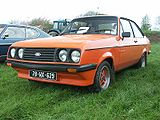
Ford Escort RS2000
Model maintenance
Already in August 1975, there were the first small technical changes, such as a better-fitting exhaust system, a reinforced alternator bracket and an electromagnetic shut-off valve as a retrofit (so-called anti-diesel kit) to prevent the engine from running after shutting down ("after-diesel"). The valve was soon taken over into the series ex works. These small detail changes resulted from initial observations by customers, workshops and tests by trade journals.
In August 1977, the German version of the Escort received its first recognizable facelift, with the front grille, trunk lid and steering wheel hub cover featuring the oval Ford logo instead of the previous lettering consisting of individual letters (in the steering wheel previously Escort lettering in cursive). Furthermore, the equipment in details as well as the color palette and the upholstery fabrics were changed.
From spring 1979, with the exception of the "Sport" and RS 2000 models, all Ford Escorts from the basic version onwards received the rectangular front headlights of the previous GL and Ghia variants. The offset of the wheels was changed to widen the track. The rear axle got single leaf springs instead of the layered three-layer leaf springs before and the engine power was given on average two horsepower more, which was justified by the installation of an electrically instead of V-belt driven fan.
· .jpg)
Ford Escort (1977-1980)
· .jpg)
Rear view
·
Ford Escort Ghia (1979)
Equipment lines
The Escort was offered in Germany as basic version Escort, L, GL, Ghia, Sport and RS2000, volume model was the Escort L. In addition to the model variants one could order numerous "extras". In general Ford advertised that they offered "no naked car" (original advertising text), because heated rear windows, front disc brakes or the electric windscreen washer system were standard equipment from the basic model on, which had to be ordered and paid for separately in comparable models of other manufacturers (VW Golf, Opel Kadett). A sunroof, however, was not available.
The top model in Germany was the RS2000 (in the UK, however, it was the RS1800 with BDA engine). The 2.0-litre OHC engine with 74 kW (100 hp), which was already known from the Escort '68, received another 10 hp more, which was achieved by a modified exhaust manifold. The new engine gave the Escort higher performance. The distinguishing feature of the RS2000 was the beveled plastic front made of polyurethane with double headlights.
Special models
In 1976 the special model "Köln" was released, which was difficult to recognize from the outside, because the car mainly had an improved interior (seats from the Escort Ghia, but door panels from the Escort L), but looked like an Escort GL on the outside.
Also in 1976, Ford produced 400 units of the "RS2000 Special" as a "Group 1b" homologation version for rally/racing. This model variant was equipped with fender flares made of GRP and deep-dish 7.5Jx13 wheels in the typical RS cross design with 235/60x13 tires. Other features included a centre "Cologne" axle with a slightly narrower track and 75-percent limited slip differential, which was also used in the Capri, a triple-bearing anti-roll bar on the front axle and a Bilstein gas-pressure shock absorber. The plastic fuel tank held 60 litres to cope with the relatively high fuel requirements during a rally. The 2.0-litre OHC engine received a different camshaft, larger valves, two twin 44 IDF carburettors from Italian manufacturer Weber and a larger Y-pipe exhaust manifold, giving an output of 97 kW (132 hp).
The 1977 model "Team", which shared similar details with the special model "Team" of the Ford Taunus (colour scheme, trim, additional headlights) was easier to recognize and was oriented in appearance and chassis to the Escort Sport, but was also available with 40 kW (54 hp).
In 1978 there was a "Happy Weekend" model with upgraded interior and two-tone side stripes. These side stripes can also be found on models of foreign versions.
Motorsport
With the Escort RS1800 Björn Waldegård became 1979 and Ari Vatanen 1981 Rally World Champion, whereby only Waldegård started for the factory team, Vatanen's vehicle was used by a private team. Ford was also able to secure the 1979 marque title. In contrast to the production car from Great Britain, the car was equipped with a BDA engine with a displacement of 2 litres, which produced about 180 kW (about 245 hp) at 7,000 min-1.
The Escort II was also used in motorsport after its appearance. Ford used the trick of not registering the II as a new vehicle, but only as a modified body of the existing model. Therefore, Ford did not need to build a new homologation series. Because of the similarity of the construction of the two Escort generations, all motorsport parts of the old car could be taken over without any changes, because the new body resembled the old one very much. It was also modified for this purpose with a cleverly used hammer on the gearbox tunnel, but the battery could remain in the engine compartment. The engine was still mounted at an angle. Exclusively in Great Britain there was a version with the designation RS1800 and Cosworth engine. A total of 109 examples of this type were built. In the meantime there are far more replicas than originals. Since Ford feared a tightening of the motor sport regulations with less modification possibilities, they created a model that existed only on paper and was never produced, the Escort RS. It was an RS1800 with all the parts used in sports racing, such as the coil-sprung rear axle with trailing arms and Panhard bar, rear disc brakes, ZF five-speed gearbox and engine modifications. Although Ford had never produced such a vehicle, the large number of parts sets sold proved that a sufficiently large number of such vehicles had been built, and Ford was granted sports certification for this fictitious vehicle. All further motorsport success thereafter was achieved with either deeply modified RS1800s or stock RSs, depending on your point of view, which were the same all things considered.
At that time, the two-litre BDG engines had an output of 206 kW (280 hp) for circuit events, 250 hp for most rallies, and up to 270 hp for decidedly asphalt rallies such as the Corsica, San Remo or Monte Carlo Rally with fuel injection and dry sump lubrication. The Escort was clearly superior in power to its main rival, the Fiat 131 Rally Abarth, which usually produced no more than 220 bhp and even in asphalt competitions had no more than 250 bhp. The Fiat was able to compensate for this major power deficit with its superior independent rear suspension chassis on tarmac. As Ford was not prepared to finance appropriate modifications to the Escort, Ford often limited itself to entries in mud and snow-heavy rallies such as the 1000 Lakes in Finland, the Sweden Rally and especially the RAC in Britain, where the Escort was able to exploit its performance advantage. Nevertheless, Ford only managed to win the championship in 1979, after which it officially withdrew the Escort from motorsport. However, private teams were still very successful with the Escort for a long time.
_GL_2.0_2-door_sedan_(15177159032).jpg)
Ford Escort GL
Search within the encyclopedia
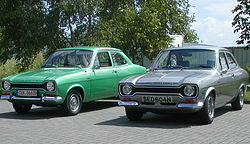
.jpg)
